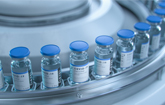The growth of the Head and Neck Cancer Drugs/Therapeutics Market is primarily driven by rising global incidence rates, increasing adoption of advanced immunotherapies, and continuous innovation in targeted drug development. Enhanced diagnostic capabilities and improving patient awareness are accelerating early treatment uptake, while expanding clinical pipelines and regulatory approvals support market expansion.
LEWES, Del., Nov. 12, 2025 /PRNewswire/ -- The Head and Neck Cancer Drugs/Therapeutics Market is experiencing substantial growth, valued at USD 4.2 Billion in 2024 and projected to reach USD 8.5 Billion by 2033. This expansion reflects increasing treatment adoption, advancements in targeted drug therapies, and growing patient populations across developed and emerging economies. Rising investment in research, supportive regulatory frameworks, and continued innovation are further driving market penetration. The strong CAGR of 8.5% expected between 2026–2033 underscores accelerating developments and continuously expanding therapeutic options.
Download PDF Brochure: https://www.marketresearchintellect.com/download-sample/?rid=219003
202 - Pages
126 – Tables
37 – Figures
Scope Of The Report
| REPORT ATTRIBUTES |
DETAILS |
| STUDY PERIOD |
2020-2031 |
| BASE YEAR |
2024 |
| FORECAST PERIOD |
2026-2033 |
| HISTORICAL PERIOD |
2020-2024 |
| UNIT |
Value (USD Billion) |
| KEY COMPANIES PROFILED |
Merck & Co., Bristol-Myers Squibb, Eli Lilly and Company, AstraZeneca, Pfizer Inc., F. Hoffmann-La Roche Ltd., Novartis AG, Sanofi S.A., GlaxoSmithKline plc, and Bayer AG. |
| SEGMENTS COVERED |
By Type, By Application And By Geography |
| CUSTOMIZATION SCOPE |
Free report customization (equivalent to up to 4 analyst working days) with purchase. Addition or alteration to country, regional & segment scope |
Head and Neck Cancer Drugs/Therapeutics Market Overview
1. Rising Global Incidence and Growing Patient Population
The Head and Neck Cancer Drugs/Therapeutics Market is significantly influenced by the increasing global incidence of cancers affecting the oral cavity, pharynx, and larynx. Factors such as smoking, excessive alcohol consumption, human papillomavirus (HPV) infections, and environmental pollutants are driving prevalence across both developed and developing regions. Aging populations and lifestyle shifts are also increasing the number of diagnosed cases annually. As healthcare awareness improves, more patients seek early diagnostics and timely treatment, supporting market expansion. The disease burden is particularly notable in Asia-Pacific and parts of Europe, where population density and socioeconomic factors contribute to higher risk exposure. Growing patient registries, screening programs, and government initiatives enhance diagnosis rates, creating sustained demand for innovative drugs and therapeutic combinations. With continued epidemiological growth, pharmaceutical companies are prioritizing research investments, pipeline diversification, and localized access strategies. This rising population of diagnosed patients remains a core driver for long-term market performance and treatment innovation.
2. Advancements in Immunotherapy and Targeted Treatment Approaches
Immunotherapy has emerged as a transformative force reshaping treatment pathways for head and neck cancers. Immune checkpoint inhibitors, monoclonal antibodies, and personalized immunomodulatory drugs are rapidly gaining adoption in clinical settings, offering improved outcomes where traditional chemotherapy may fall short. Targeted therapies designed to inhibit tumor-specific pathways have demonstrated higher precision, fewer side effects, and increased survival rates, making them attractive options for both patients and clinicians. As tumor biology is studied more comprehensively, personalized medicine continues to expand its influence, allowing patients to receive tailored therapies aligned with genetic profiles. Combination therapies integrating immunomodulators, radiotherapy, and molecular inhibitors are improving treatment response and reducing recurrence rates. Pharmaceutical companies are actively developing new biomarkers and predictive diagnostics that further enhance the effectiveness of targeted interventions. These continuous scientific breakthroughs reinforce competitive advantage, strengthen product portfolios, and create new revenue streams across global markets.
3. Increasing Clinical Trials and Research Pipeline Expansion
The market is experiencing substantial momentum due to expanding research pipelines and numerous clinical trials evaluating novel therapeutic candidates. Biopharmaceutical companies are heavily investing in next-generation drugs focused on biological targets, immunomodulation, and multi-mechanism treatment strategies. Clinical trials are increasingly exploring combination therapies that integrate checkpoint inhibitors, precision medicine, and radiotherapeutic enhancements. Strong participation from academic cancer centers, oncology institutes, and contract research organizations accelerates the development process and supports regulatory progression. Governments and health agencies are offering incentives, grants, and expedited review pathways to encourage innovation and fast-track breakthrough therapies. This robust pipeline ensures continuous product introductions, improves therapeutic diversity, and enhances competition. The rising number of Phase II and Phase III candidates demonstrates growing confidence in safety and efficacy outcomes. Pipeline expansion remains a major contributor to sustained market growth, promising improved survival rates and broader treatment alternatives for patients worldwide.
4. Regulatory Support and Favorable Approval Frameworks
Regulatory agencies worldwide are increasingly supportive of advanced cancer therapies, offering accelerated approval pathways, orphan drug designations, and priority reviews for novel head and neck cancer drugs. This support recognizes the urgency of treatment innovation and the unmet needs in recurrent or metastatic patient populations. Streamlined regulatory frameworks encourage manufacturers to invest confidently in research and expedite commercialization timelines. Harmonization of regulatory standards across regions further facilitates global distribution and collaboration. Manufacturers benefit from flexible reimbursement policies in many countries, improving patient affordability and market access. Post-market surveillance initiatives ensure safety, driving continuous drug refinement. In addition, government partnerships with private oncology research organizations foster innovation through funded studies and infrastructure support. These regulatory advantages reduce risk, increase transparency, and strengthen treatment availability in emerging markets. Ultimately, regulatory optimism continues to reinforce industry growth and maintain a healthy competitive environment for future drug launches.
Download Sample Report Now: https://www.marketresearchintellect.com/download-sample/?rid=219003
5. Technological Integration and Digital Health Advancements
Technological integration is transforming the landscape of head and neck cancer treatment by enabling more precise diagnostics, enhanced treatment planning, and improved patient monitoring. Artificial intelligence and machine learning models assist clinicians in detecting early-stage cancers, optimizing drug combinations, and predicting patient responses. Digital biomarkers and genomic sequencing tools support personalized treatment customization, increasing therapeutic success rates. Telemedicine platforms allow oncologists to monitor treatment progress remotely, improving care accessibility for rural or mobility-limited patients. Electronic health records streamline treatment coordination among multidisciplinary teams, reducing delays and improving therapeutic outcomes. Wearable health devices and apps enable continuous monitoring of side effects, supporting faster clinical decision-making. These technological advancements accelerate drug research cycles and optimize clinical trial recruitment through real-world patient data. As digital oncology expands, patient engagement improves and treatment inefficiencies decline. Technology-driven precision solutions continue to significantly elevate the market's value proposition and competitive strength.
6. Strategic Collaborations and Industry Partnerships
Strategic collaborations are becoming a cornerstone for innovation in the Head and Neck Cancer Drugs/Therapeutics Market. Pharmaceutical companies, biotechnology firms, academic institutions, and research laboratories are forming alliances to share technology platforms, clinical expertise, and discovery resources. These partnerships enable faster product development and reduce research-related financial risk. Co-developed clinical trials allow organizations to evaluate combination therapies, expanding treatment possibilities and improving patient response outcomes. Mergers and acquisitions strengthen product portfolios and secure access to proprietary technologies. Collaborations with diagnostic companies support the development of companion tests that enable more precise patient selection. Governments and international cancer foundations also offer research funding, supporting novel drug advancements. Such partnerships accelerate regulatory approvals and streamline commercialization in multiple regions simultaneously. Ultimately, strategic cooperation drives greater innovation, reduces market entry barriers, and ensures continuous availability of effective treatment options in an evolving oncology ecosystem.
7. Growing Adoption in Emerging Markets and Healthcare Infrastructure Improvements
Emerging markets are playing an increasingly important role in the global expansion of head and neck cancer therapeutics. Countries across Asia-Pacific, Latin America, and Eastern Europe are investing heavily in oncology infrastructure, improving diagnostic centers, radiotherapy facilities, and specialized treatment units. Rising healthcare budgets and national cancer control programs have accelerated access to advanced therapeutics. Pharmaceutical companies are focusing on regional manufacturing partnerships and distribution networks to improve affordability and regulatory alignment. Increasing awareness campaigns are educating populations about high-risk behaviors, encouraging earlier screening and reducing late-stage detection rates. Multinational companies are also launching patient support programs to subsidize treatment costs, improving adoption. As middle-class populations expand, demand for innovative treatment solutions grows accordingly. These improvements are positioning emerging markets as future growth hubs, contributing significantly to industry revenue while supporting global treatment equity.
8. Challenges and Competitive Pressures Influencing Market Performance
Despite strong growth potential, the Head and Neck Cancer Drugs/Therapeutics Market faces challenges that impact widespread adoption and commercialization. High treatment costs and limited reimbursement in certain regions restrict patient access, especially to immunotherapies and targeted drugs. Side effects associated with aggressive treatments, including toxicity and immune-related reactions, require careful clinical management. Competition among pharmaceutical companies intensifies as patents expire and biosimilars enter the market, increasing pricing pressure. Limited access to advanced diagnostics in rural settings delays treatment initiation, reducing survival prospects. Complex regulatory documentation and long clinical trial timelines create barriers for emerging manufacturers. Additionally, patient adherence can be affected by lengthy treatment cycles and financial burden. Nonetheless, continuous innovation, improved insurance frameworks, and expansion of supportive care solutions are steadily mitigating these obstacles, ensuring sustained market resilience.
Geographic Dominance:
The Head and Neck Cancer Drugs/Therapeutics Market demonstrates strong geographic dominance led primarily by North America, driven by highly advanced healthcare infrastructure, comprehensive oncology programs, and significant R&D investments from leading pharmaceutical companies. The region benefits from higher awareness levels, broad access to immunotherapy, and supportive reimbursement policies, which accelerate adoption rates. Europe follows closely, supported by government-funded research initiatives, growing clinical trial activity, and well-established cancer care networks. Asia-Pacific is emerging as the fastest-growing region due to increasing patient populations, improved diagnostic capabilities, and expanding healthcare expenditures across China, India, and Japan. Additionally, national screening programs and greater technological integration contribute to accelerated growth. Latin America and the Middle East & Africa show gradual expansion supported by investments in oncology infrastructure and rising patient awareness, though limited availability of advanced treatments remains a challenge. Collectively, these regional dynamics create a diverse market landscape driven by innovation, accessibility, and strategic policy alignment.
Head and Neck Cancer Drugs/Therapeutics Market Key Players Shaping the Future
Key players shaping the Head and Neck Cancer Drugs/Therapeutics Market include Merck & Co., Bristol-Myers Squibb, Eli Lilly and Company, AstraZeneca, Pfizer Inc., F. Hoffmann-La Roche Ltd., Novartis AG, Sanofi S.A., GlaxoSmithKline plc, and Bayer AG.
These companies are actively expanding pipelines, securing regulatory approvals, initiating strategic collaborations, and investing heavily in immunotherapy and targeted drug development to strengthen global competitiveness and enhance treatment outcomes.
Head and Neck Cancer Drugs/Therapeutics Market Segment Analysis
The Head and Neck Cancer Drugs/Therapeutics Market is segmented based on By Type, By Application, and Geography, providing a comprehensive framework for industry analysis:
1. By Type
- Chemotherapy Drugs
Used extensively for both early and advanced cancer stages, focusing on tumor shrinkage and recurrence prevention. - Targeted Therapies
Designed to inhibit specific cancer pathways and reduce treatment-related toxicity. - Immunotherapy Drugs
Boost patient immune responses through checkpoint inhibitors and biological modulators.
2. By Application
- Surgical Oncology
Involves removal of tumors combined with post-treatment therapies to reduce recurrence. - Radiation and Chemoradiation Therapy
Used to treat localized tumors and complement drug-based therapeutic cycles. - Metastatic and Recurrent Cancer Management
Focuses on patients where the disease has spread or reappeared, requiring advanced therapeutic combinations.
3. By Geography
- North America
Dominates due to advanced facilities, strong clinical pipelines, and high treatment adoption rates. - Europe
Supported by robust research funding and comprehensive regulatory frameworks. - Asia-Pacific
Fastest-growing region due to rising incidence rates and improving healthcare access. - Latin America & Middle East/Africa
Gradual growth supported by developing oncology infrastructure and awareness initiatives.
Healthcare and Pharmaceuticals
The Healthcare and Pharmaceuticals sector plays a pivotal role in advancing the Head and Neck Cancer Drugs/Therapeutics Market by continuously driving innovation, enhancing treatment pathways, and expanding access to specialized oncology solutions. Pharmaceutical companies are investing heavily in research pipelines focused on immunotherapies, biologics, and molecularly targeted agents to improve survival rates and reduce treatment-related toxicities. Within healthcare systems, advanced diagnostic imaging, precision medicine platforms, and multidisciplinary care teams enable more accurate staging and personalized therapy planning. Hospitals and cancer institutes are adopting digital tools such as AI-powered tumor analysis and genomic sequencing to refine treatment response. Pharmaceutical manufacturers are also collaborating with biotech firms and academic research bodies to accelerate clinical trials and expedite regulatory approvals. Additionally, improvements in reimbursement policies, tele-oncology services, and patient support programs are increasing accessibility across both developed and emerging markets. Collectively, these healthcare and pharmaceutical advancements continue to elevate treatment effectiveness and shape long-term market growth.
Our related Reports
Global Anti-Counterfeiting And Anti-Theft Packaging Market Size, Analysis By Type (RFID (Radio-Frequency Identification), Barcode, Hologram, Taggants, Tamper-Evident), By Application (Pharmaceuticals, Food & Beverage, Luxury Goods, Automotive, Electronics ), By Geography, And Forecast
Global Graphitization Furnace Market Size, Growth By Application (Steelmaking, Semiconductor Manufacturing, Energy Storage (Lithium-ion Batteries), Aerospace, Nuclear Industry, Research & Development), By Product (Acheson Furnace, Continuous Graphitization Furnace, Cast Graphitization Furnace, Electrically Heated Furnace), Regional Insights, And Forecast
Global Grape Seed Extract Products Market Size By Type (Powdered Grape Seed Extract, Liquid Grape Seed Extract, Capsule and Tablet Form, Oil-Based Grape Seed Extract, Organic Grape Seed Extract), By Application (Dietary Supplements, Pharmaceuticals, Cosmetics and Personal Care, Functional Foods and Beverages, Animal Nutrition), By Region, and Forecast to 2033
Global Modular Remote Terminal Unit Market Size, Analysis By Application (Oil & Gas Industry, Smart Grids, Environmental Monitoring, Water & Wastewater Management, Transportation Systems, Industrial Automation, Building Automation, Agriculture, Telecommunications, Healthcare Facilities), By Product (Standalone RTUs, Modular RTUs, Compact RTUs, Intelligent RTUs, Wireless RTUs, Hybrid RTUs, Solar-Powered RTUs, Explosion-Proof RTUs, Rack-Mount RTUs, Portable RTUs), By Geography, And Forecast
Global Fuel Cell Power System Market Size By Type (Proton Exchange Membrane Fuel Cells (PEMFC), Solid Oxide Fuel Cells (SOFC), Molten Carbonate Fuel Cells (MCFC), Phosphoric Acid Fuel Cells (PAFC), Alkaline Fuel Cells (AFC)), By Application ( Transportation, Stationary Power Generation, Portable Power Systems, Industrial Power Solutions, Residential Energy Systems), By Region, And Future Forecast
About Us: Market Research Intellect
Welcome to Market Research Intellect, where we lead the way in global research and consulting, proudly serving over 5,000 esteemed clients worldwide. Our mission is to empower your business with cutting-edge analytical research solutions, delivering comprehensive, information-rich studies that are pivotal for strategic growth and critical revenue decisions.
Unmatched Expertise: Our formidable team of 250 highly skilled analysts and subject matter experts (SMEs) is the backbone of our operations. With extensive training in advanced data collection and governance, we delve into over 25,000 high-impact and niche markets. Our experts seamlessly integrate modern data collection techniques, robust research methodologies, and collective industry experience o produce precise, insightful, and actionable research.
Diverse Industry Coverage: We cater to a wide array of industries, ensuring that our insights are both relevant and specialized. Our expertise spans: Energy, Technology, Manufacturing and Construction, Chemicals and Materials, Food and Beverages
Having collaborated with numerous Fortune 2000 companies, we bring unparalleled experience and reliability to meet all your research needs. Our proven track record reflects our commitment to excellence and client satisfaction.
Contact Us:
Mr. Edwyne Fernandes
Market Research Intellect
Call Us on: +1 743 222 5439
Email: sales@marketresearchintellect.com
Web: https://www.marketresearchintellect.com/
Logo: https://mma.prnewswire.com/media/2483702/Market_Research_Intellect_Logo.jpg






Share this article